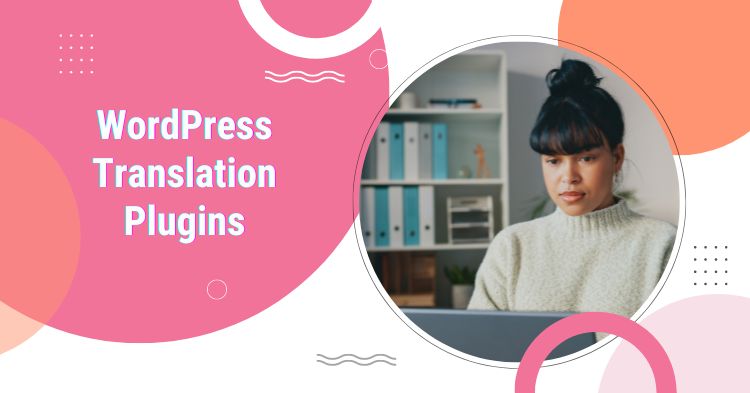Having a website that speaks multiple languages is about welcoming diverse audiences and growing your reach. With WordPress, creating a multilingual site is easier than you think — thanks to handy translation plugins.
Over half the internet’s content is in English, but only about 25% of users are native English speakers. That means a huge chunk of visitors might be missing out on your awesome website simply because they don’t understand the language.
But don’t worry! Multilingual WordPress sites and translation plugins are here to help bridge that language gap. By opening up content to different languages using the best WordPress plugins, you’re not only inviting more visitors to your site, but you’re also building trust with people from all over the world.
So, in this blog, let’s discuss how these handy translation plugins can make that happen!
How to Choose the Right WordPress Translation Plugins
There are many multilingual WordPress out there. Here’s how you can choose the right WordPress translation plugins.
#1 Human Touch vs. Robot Talk
The first thing to consider is how you want your content translated. Some translation plugins use machines (think Google Translate), while others connect you with real human translators. There are even some that offer a mix of both. It’s up to you to decide what works best for your needs and budget, adds Dan Tabaran, Head of Marketing at Influencity.
#2 Language Variety
How many languages do you want to offer on your site? Make sure the plugin you choose supports all the languages you have in mind.
It’s also a good idea to check if they offer updates for new languages in case you want to expand later on.
#3 Easy Does It
Chase Hughes, Founder of ProAI, says, “Nobody wants to spend hours figuring out how to use translation plugins. Look for one that’s user-friendly and has a clear interface. You should be able to add and manage translations without pulling your hair out.”
#4 Playing Nice with Google
Search engine optimization (SEO) is important for getting your site noticed. Make sure the plugin you choose is SEO-friendly — meaning it helps your translated pages show up in search results in different languages.
#5 Get Along with Others
Your translation plugin needs to play well with your WordPress theme and other plugins you’re using. Check the compatibility before installing to avoid any headaches down the road, said Robbin Schuchmann, Co-Founder of Employ Borderless.
#6 A Helping Hand
Even the best translation plugins can have hiccups sometimes. Choose one that offers reliable support, whether it’s through documentation, forums, or direct contact with the developers. It’s always good to know someone’s got your back.
#7 Free vs. Paid
Translation plugins come in free and paid versions. Free ones are great for getting started, but paid ones often offer more features, languages, and better support.
Consider your budget and what you need before making a decision.
#8 Read the Reviews
Before you settle on a plugin, see what other users have to say. Read reviews and compare different options to find one that fits your specific requirements and budget, adds Mateusz Mazurek, Founder at Prehost.
Top 5 Translation Plugins for Your Multilingual Adventure
Let’s find out the five best translation plugins.
#1 WPML
WPML offers an array of features for building and managing multilingual websites. It supports over 40 languages, allows for manual and automatic translation. Also, it seamlessly integrates with popular SEO plugins.
Sumeer Kaur, Founder of Saree, shares, “WPML extensive features make it a bit complex for beginners.”
#2 Polylang
Polylang makes it easy to translate posts, pages, media, categories, and even custom post types. It automatically handles creating language-specific URLs for better SEO. And you can also customize your language switcher to match your site’s look and feel. It’s actually a good choice for those who prioritize simplicity and ease of use.
#3 TranslatePress
This innovative plugin allows you to translate your website directly from the front-end — giving you a real-time preview of your translations. It’s useful for visually-oriented users who want complete control over the translation process.
#4 Weglot
Weglot offers a cloud-based translation solution. It automatically detects and translates your content, saving you time and effort.
While it’s a convenient option, it is not the most cost-effective for larger websites with extensive content.
#5 GTranslate
GTranslate is a handy tool for those who want a quick and easy way to make their site multilingual. It seamlessly integrates with Google Translate, allowing you to offer translations in over 100 languages.
It’s a good starting point for smaller websites or those on a budget, but for more nuanced or complex content, consider options that offer professional human translation alongside machine translation.
Let’s take inspiration from Emirates, a well-known international airline. They use a multilingual website to connect with passengers from diverse backgrounds. Their website is available in over 20 languages, which enables them to cater to a broad spectrum of travelers and establish a strong global presence.
Why Your WordPress Site Needs to Speak Multiple Languages
Alright, here are some benefits of multilingual WordPress sites.
A Warm Welcome to Everyone
Martin Seeley, CEO of Mattress Next Day, explains, “By having your site available in multiple languages, you’re essentially rolling out the red carpet for visitors from all over the world. It’s like saying, Hey, come on in! We’re happy you’re here, and we speak your language.”
More Traffic, More Opportunities
A website that is available in various languages draws in a larger audience, just like a bustling market does.
People are more inclined to investigate your products, remain on your website longer, and even turn into loyal consumers or customers when they can discover material in their native tongue.
Google Loves It
In an interview Alison Lancaster, CEO of Pressat.co.uk, shares, “Did you know that having a multilingual site boosts your ranking in search engine results? This is because language is a major factor in Google’s goal to provide the most relevant material to users. Thus, translating your website helps you become noticed by search engines and increase your website’s visibility.”
Stand Out from the Crowd
A multilingual website is your unique identifier. It sets you apart from competitors who haven’t yet embraced global communication. Having this distinction offers you a great advantage — particularly in fields with a global clientele.
Build Trust and Understanding
When you try to speak with someone in their mother tongue, you gain their respect and trust. They feel understood and valued, which obviously leads to stronger relationships with customers and clients, adds Idan Avitan, CEO of Growee.
Unlock New Markets
Multilingual websites are your ticket to exploring the world’s largest marketplace — the internet. You tap into new markets, reach customers you never thought possible, and grow your business.
Let’s take the example of Nike, the global sportswear giant. They use a multilingual website to connect with customers around the world.
Their site is available in over 40 languages, and this approach has undoubtedly helped them expand their reach and build a loyal following in diverse markets.
How to Implement a Multilingual WordPress Site
Here are some simple steps to implement a multilingual WordPress site.
Picking Your Partner
The first step is to choose your translation plugin and install it on your WordPress site. It’s as easy as installing any other plugin. Just head over to the “Plugins” section in your WordPress dashboard, search for the translation plugins you want, and click “Install Now.” Once it’s installed, don’t forget to activate it, shares Joshua D’Souza, Co-Founder & CEO of CloudSafaris.
Configure Languages and Settings
Now it’s time to tell your translation plugins what languages you want to offer on your site. Head to the plugin’s settings page and add the languages you have in mind.
Usually, you’ll set one as your default language (the one your site is currently in), and the rest will be the additional languages you want to offer. You also find some other settings here, like choosing how you want your language switcher to look (the little menu or buttons that let visitors change the language).
Let’s Get Translating
Now you need to start translating your content. Depending on the translation plugins you choose, you have different options.
Gerrid Smith, CMO of Joy Organics, explains, “Some translation plugins offer automatic translation (using machine translation), while others allow you to manually translate each piece of content yourself.
Some even let you hire professional translators right through the plugin. Choose the method that works best for you and start translating your pages, posts, menus, and everything else you want to make available in multiple languages.”
Guide Your Visitors
Make it simple for your visitors to discover your material after it has been translated. The tools to construct a language switcher are usually included in your translation plugin. For ease of language switching, this can be represented by a straightforward dropdown menu, a series of flags, or buttons.
For easy accessibility for visitors, make sure your language switcher is placed in a noticeable area of your website, such as the header or sidebar.
Optimize for SEO
Optimize your multilingual website for search engines in order to guarantee that it ranks highly in search results. In order to do this, hreflang tags—tiny pieces of code that identify the language a certain page is in—must be used.
Plus, always double-check even if your translation plugins take care of this for you automatically. Plus, you should make distinct XML sitemaps for every language and submit them to search engines.
Managing Your Multilingual Site
The job doesn’t end when your multilingual website launches. Keep an eye out for typos or broken links, update your translations often, and track how well your website performs across various languages.
To monitor how your website is doing across various geographies and make any modifications, think about using analytics tools. And a good multilingual website is the one which is maintained.
Testing, Testing, 1, 2, 3
Before you officially launch your multilingual site, test everything thoroughly. Click through every page in each language, check for broken links, and make sure the translations are accurate and natural-sounding.
You should even request reviews and feedback from native speakers of each language on your website.
Promote Your Multilingual Site
When your website is prepared, announce it to the public! To obtain more visitors, post it on social media, get in touch with communities who speak the languages you want to target, and think about placing targeted advertisements.
The larger your reach, the more individuals who will be aware of your multilingual website.
For example, Edgard & Cooper, a pet food company with a global mission, understands the importance of reaching pet parents worldwide.
Their website greets you with a warm, inviting design and offers a handy language switcher right up front. This allows shoppers from Belgium to Brazil to easily browse in their preferred language.
They tailor their content and social media posts to specific languages and cultures, making their brand feel personal and relevant to diverse audiences.
Best Tips for a Smooth Multilingual Journey
Now that you’re on your way to creating a multilingual WordPress site, here are some tips to make your journey even smoother.
Culture Counts
Remember, translation involves more than merely word substitution. It all comes down to knowing other cultures and crafting material that appeals to a wide range of audiences.
Consider how colors, images, and even humor might be interpreted differently in various cultures, and adjust your content accordingly.
Design for Everyone
A multilingual site should be easy for everyone to navigate, no matter what language they speak. Keep your WordPress website design simple and intuitive, with clear navigation menus and a user-friendly layout. Consider using visual cues like flags or language names to help visitors easily identify their preferred language.
Local Flavors
When it comes to images and videos, think local. People connect better with visuals that reflect their own culture and experiences. Swap out generic stock photos with images that resonate with your target audience in each language.
Legal Matters
Different countries have different rules and regulations when it comes to online content. Make sure you’re aware of any legal requirements specific to the languages and regions you’re targeting. This includes things like privacy policies, cookie notices, or even age restrictions for certain content.
Wrap-Up
It’s not hard to create a WordPress multilingual website. With the right tools and a bit of planning, you can open your digital doors to the world.
Remember, it’s not just about translating words — it’s about connecting with people from different cultures and backgrounds, building trust, and growing your online presence.
So, take the plunge and start your multilingual journey with translation plugins today!



![Read more about the article 21 Best YouTube Video Downloaders in 2023 [Free & Paid]](https://www.hoothemes.com/wp-content/uploads/2023/04/1-1-300x157.jpg)

